Design and Analysis of fT-Doubler-Based RF Amplifiers in SiGe HBT Technology
Abstract
1. Introduction
2. Proposed fT-Doubler RF Amplifier with TSVs
2.1. Input and Output Matching
2.2. Noise Figure Calculation
3. Measurement Results and Discussion
4. Conclusions
Author Contributions
Funding
Conflicts of Interest
References
- Cressler, J.D. Radiation effects in SiGe technology. IEEE Trans. Nucl. Sci. 2013, 60, 1992–2014. [Google Scholar] [CrossRef]
- Cressler, J.D. Silicon-Germanium as an enabling technology for extreme environment electronics. IEEE Trans. Device Mater. Reliab. 2010, 10, 437–448. [Google Scholar] [CrossRef]
- Banerjee, G.; Niu, G.; Cressler, J.D.; Clark, S.D.; Palmer, M.J.; Ahlgren, D.C. Anomalous dose rate effects in gamma irradiated SiGe heterojunction bipolar transistors. IEEE Trans. Nucl. Sci. 1999, 46, 1620–1626. [Google Scholar] [CrossRef]
- Zhang, J.; Guo, Q.; Guo, H.; Lu, W.; He, C.; Wang, X.; Li, P.; Liu, M. Impact of bias conditions on total ionizing dose effects of 60Coγ in SiGe HBT. IEEE Trans. Nucl. Sci. 2016, 63, 1251–1258. [Google Scholar] [CrossRef]
- Cressler, J.D.; Mantooth, H.A. Extreme Environment Electronics; CRC Press: Boca Raton, FL, USA, 2012. [Google Scholar]
- Shen, P.; Zhang, W.; Xie, H.; Jin, D.; Zhang, W.; Li, J.; Gan, J. An ultra-wideband darlington low noise amplifier design based on SiGe HBT. In Proceedings of the International Conference on Microwave and Millimeter Wave Technology, Nanjing, China, 21–24 April 2008; Volume 3, pp. 1372–1375. [Google Scholar] [CrossRef]
- Paek, J.-S.; Park, B.; Hong, S. CMOS LNA with darlington-pair for UWB systems. Electron. Lett. 2006, 42, 913–914. [Google Scholar] [CrossRef]
- Elahipanah, H.; Salemi, A.; Zetterling, C.-M.; Östling, M. Intertwined design: A novel lithographic method to realize area efficient high-voltage SiC BJTs and darlington transistors. IEEE Trans. Electron Devices 2016, 63, 4366–4372. [Google Scholar] [CrossRef]
- Nikandish, G.; Medi, A. Design and analysis of broadband Darlington amplifiers with bandwidth enhancement in GaAs pHEMT technology. IEEE Trans. Microw. Theory Tech. 2014, 62, 1705–1715. [Google Scholar] [CrossRef]
- Weng, S.-H.; Chang, H.-Y.; Chiong, C.-C.; Wang, Y.-C. Gain-bandwidth analysis of broadband darlington amplifiers in HBT-HEMT process. IEEE Trans. Microw. Theory Tech. 2012, 60, 3458–3473. [Google Scholar] [CrossRef]
- Krishnamurthy, K.; Vetury, R.; Keller, S.; Mishra, U.; Rodwell, M.J.; Long, S.I. Broadband GaAs MESFET and GaN HEMT resistive feedback power amplifiers. IEEE J. Solid-State Circuits 2000, 35, 1285–1292. [Google Scholar] [CrossRef]
- Feghhi, R.; Joodaki, M. Realization of a broadband hybrid X-band power amplifier based on fT-doubler technique. AEU-Int. J. Electron. Commun. 2019, 104, 119–127. [Google Scholar] [CrossRef]
- El-Gabaly, A.M.; Stewart, D.; Saavedra, C.E. 2-W broadband GaN power-amplifier RFIC using the fT doubling technique and digitally assisted distortion cancellation. IEEE Trans. Microw. Theory Tech. 2013, 61, 525–532. [Google Scholar] [CrossRef]
- Yuan, J.; Cressler, J.D. Enhancing the speed of SiGe HBTs using fT-Doubler techniques. In Proceedings of the IEEE Topical Meeting on Silicon Monolithic Integrated Circuits in RF Systems, Orlando, FL, USA, 23–25 January 2008; pp. 50–53. [Google Scholar] [CrossRef]
- Jain, V.; Gross, B.J.; Pekarik, J.J.; Adkisson, J.W.; Camillo-Castillo, R.A.; Liu, Q.; Gray, P.B.; Vallett, A.; Divergilio, A.W.; Zetterlund, B.K.; et al. Investigation of HBT Layout Impact on fT Doubler Performance for 90 nm SiGe HBTs. In Proceedings of the IEEE Bipolar/BiCMOS Circuits and Technology Meeting (BCTM), Coronado, CA, USA, 28 September–1 October 2014; pp. 5–8. [Google Scholar] [CrossRef]
- Song, I.; Cho, M.-K.; Jung, S.; Ju, I.; Cressler, J.D. Advantages of utilizing through-silicon-vias in SiGe HBT RF low-noise amplifier design. Microw. Opt. Tech. Lett. 2015, 57, 2703–2706. [Google Scholar] [CrossRef]
- Joseph, A.J.; Gillis, J.D.; Doherty, M.; Lindgren, P.J.; Previti-Kelly, R.A.; Malladi, R.M.; Wang, P.-C.; Erturk, M.; Ding, H.; Gebreselasie, E.G.; et al. Through-silicon vias enable next-generation SiGe power amplifiers for wireless communications. IBM J. Res. Dev. 2008, 52, 635–648. [Google Scholar] [CrossRef]
- Tian, W.; Ma, T.; Liu, X. TSV Technology and high-energy heavy ions radiation impact review. Electronics 2018, 7, 112. [Google Scholar] [CrossRef]
- Liao, H.-Y.; Chiou, H.-K. RF model and verification of through-silicon vias in fully integrated SiGe power amplifier. IEEE Electron Device Lett. 2011, 32, 809–811. [Google Scholar] [CrossRef]
- Razavi, B. RF Microelectronics, 2nd ed.; Prentice Hall: Upper Saddle River, NJ, USA, 2011. [Google Scholar]
- Song, I.; Koo, M.; Jung, H.; Jhon, H.-S.; Shin, H. Optimization of cascode configuration in CMOS low-noise amplifier. Microw. Opt. Tech. Lett. 2008, 50, 646–649. [Google Scholar] [CrossRef]
- Girlando, G.; Palmisano, G. Noise figure and impedance matching in RF cascode amplifiers. IEEE Trans. Circuits Syst. II Analog Digit. Signal Process. 1999, 46, 1388–1396. [Google Scholar] [CrossRef]
- Cressler, J.D.; Niu, G. Silicon-Germanium Heterojunction Bipolar Transistors; Artech House: Norwood, MA, USA, 2002. [Google Scholar]
- Harame, D.; Larson, L.; Case, M.; Kovacic, S.; Voinigescu, S.; Tewksbury, T.; Nguyen-Ngoc, D.; Stein, K.; Cressler, J.; Jeng, S.-J.; et al. SiGe HBT technology: Device and application issues. In Proceedings of the International Electron Devices Meeting, Washington, DC, USA, 10–13 December 1995; pp. 731–734. [Google Scholar] [CrossRef]
- Joseph, A.; Liu, Q.; Hodge, W.; Gray, P.; Stein, K.; Previti-Kelly, R.; Lindgren, P.; Gebreselasie, E.; Voegeli, B.; Candra, P.; et al. A 0.35 μm SiGe BiCMOS technology for power amplifier applications. In Proceedings of the IEEE Bipolar/BiCMOS Circuits and Technology Meeting, Boston, MA, USA, 30 September–2 October 2007; pp. 198–201. [Google Scholar] [CrossRef]
- Seif, M.; Pascal, F.; Sagnes, B.; Elbeyrouthy, J.; Hoffmann, A.; Haendler, S.; Chevalier, P.; Gloria, D. Characterization, Modeling and Comparison of 1/f Noise in Si/SiGe:C HBTs Issued from Three Advanced BiCMOS Technologies. In Proceedings of the 29th International Conference on Microelectronics (ICM), Beirut, Lebanon, 10–13 December 2017; pp. 1–4. [Google Scholar] [CrossRef]
- Melai, J.; Magnée, P.; Pouwel, I.; Weijs, P.; Brunets, I.; van Dalen, R.; Vohra, A.; Tiemeijer, L.; Pijper, R.; Tuinhout, H.; et al. QUBiC generation 9, a new BiCMOS process optimized for mmWave applications. In Proceedings of the 2015 IEEE Bipolar/BiCMOS Circuits and Technology Meeting-BCTM, Boston, MA, USA, 26–28 October 2015; pp. 113–116. [Google Scholar] [CrossRef]
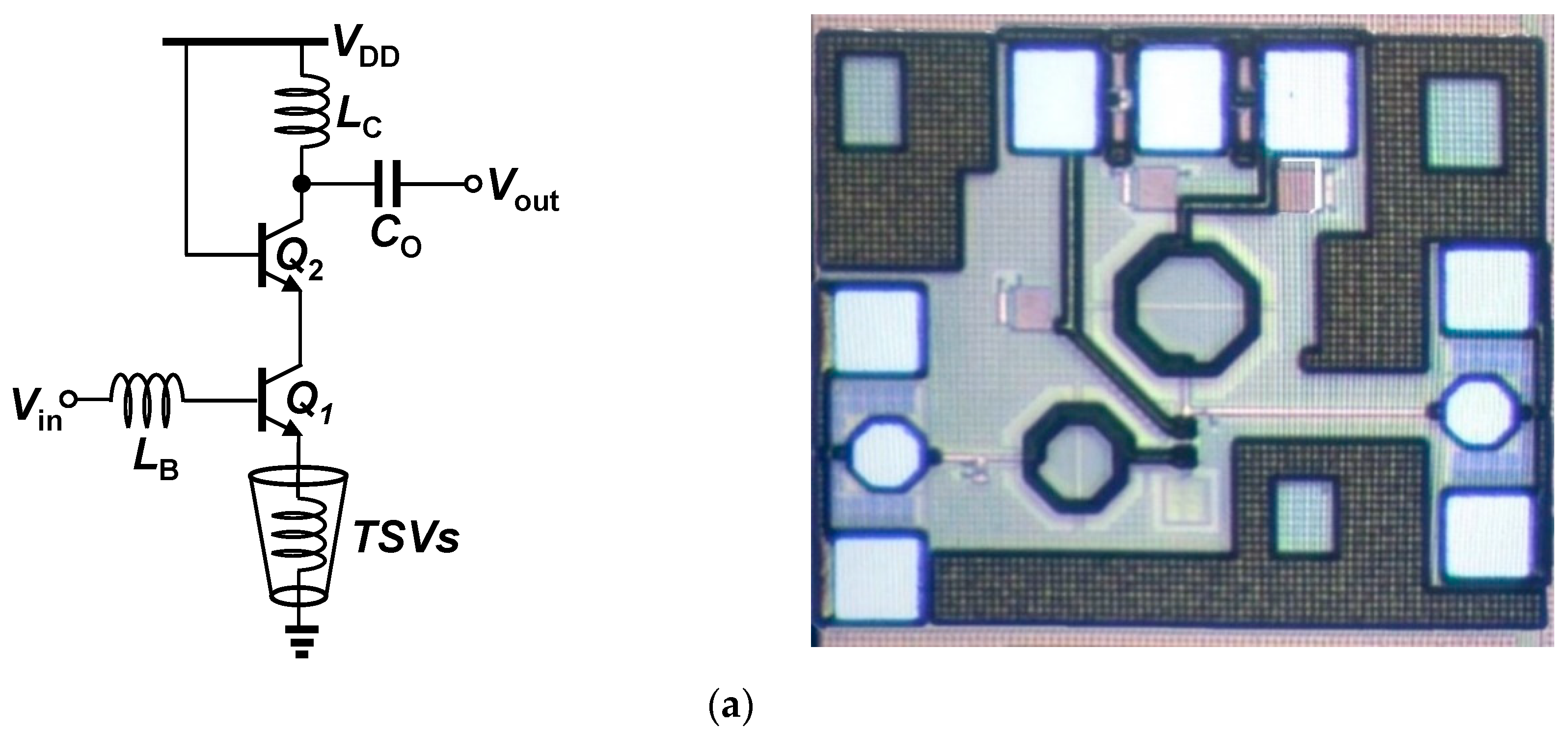
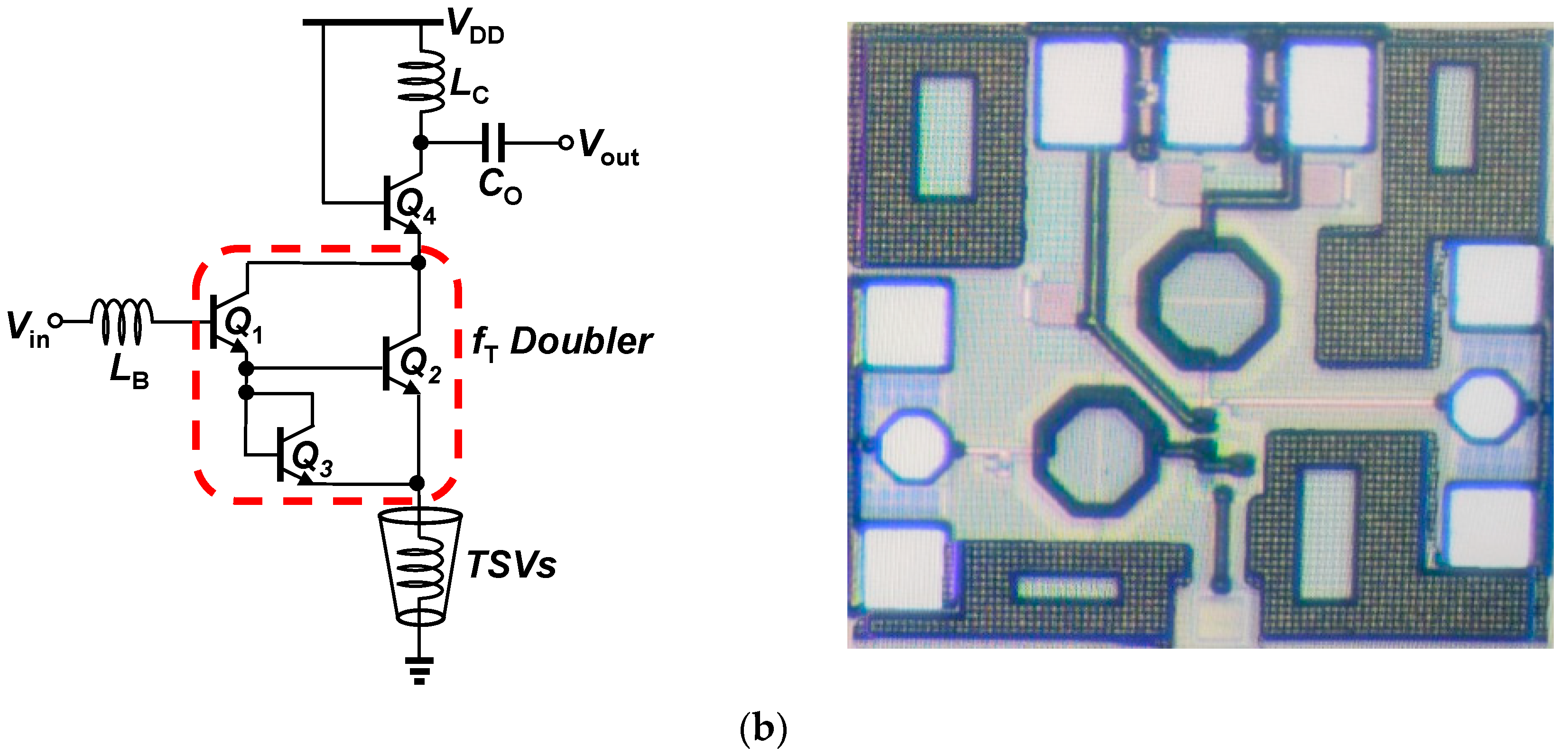
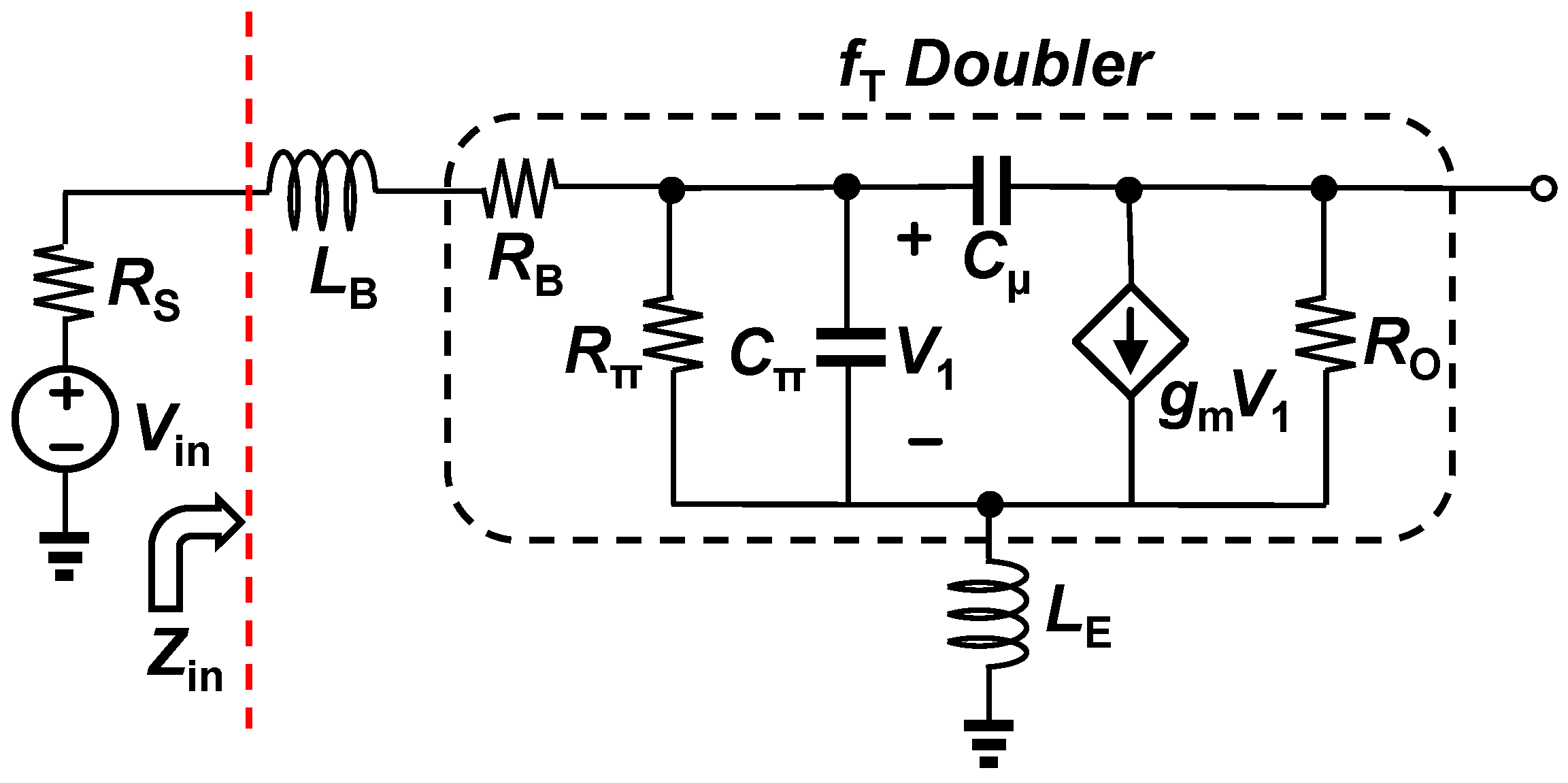
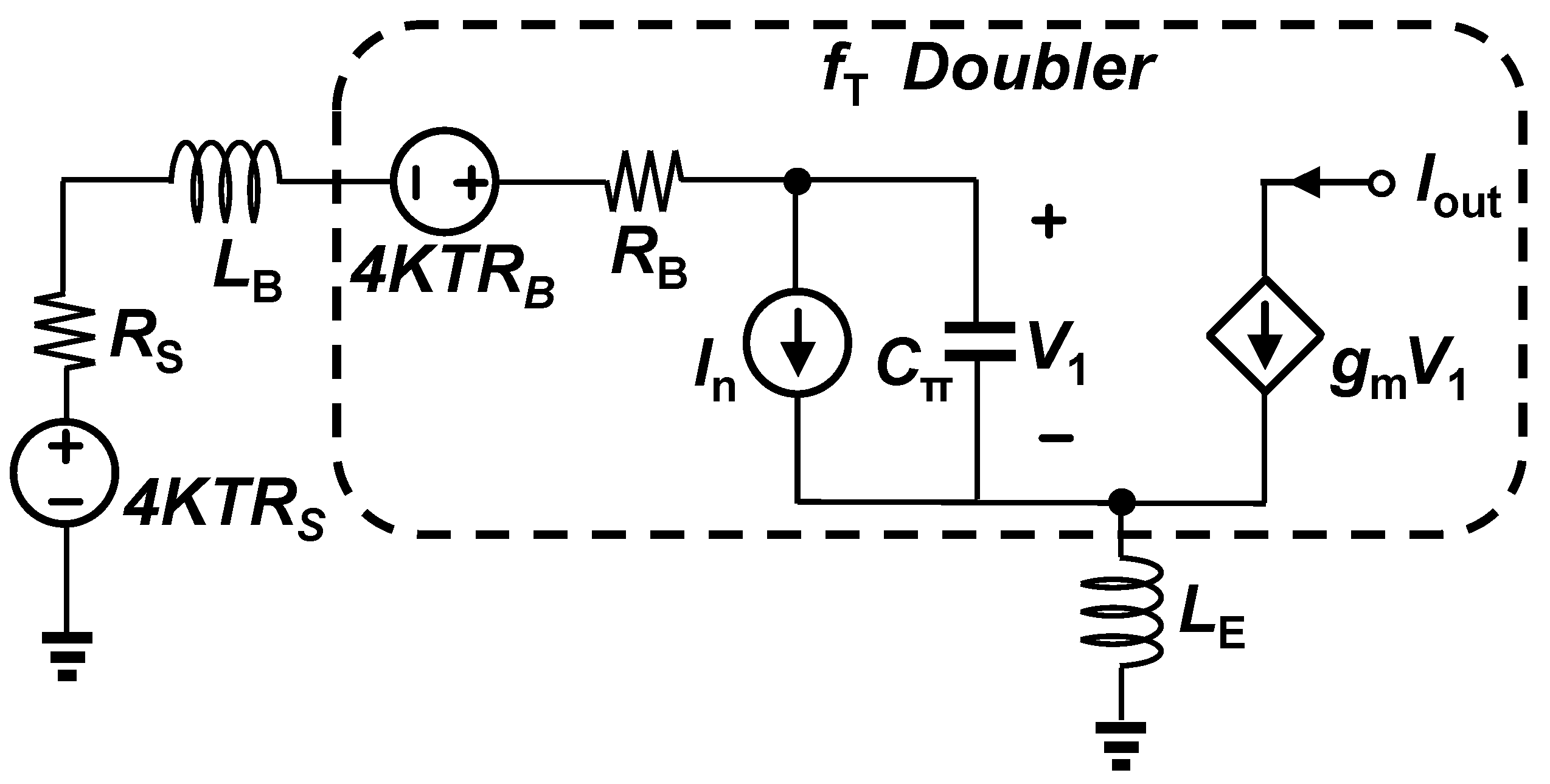
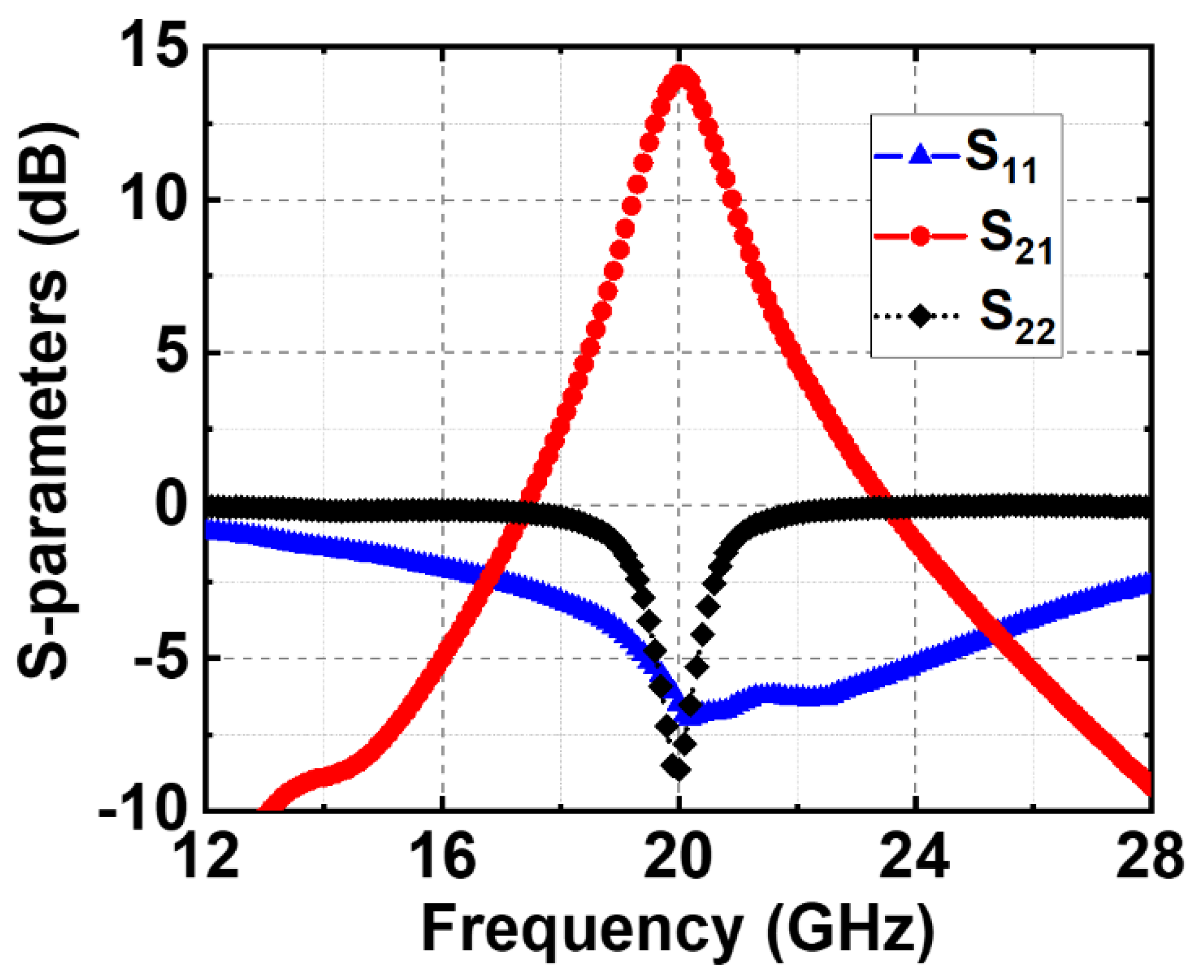
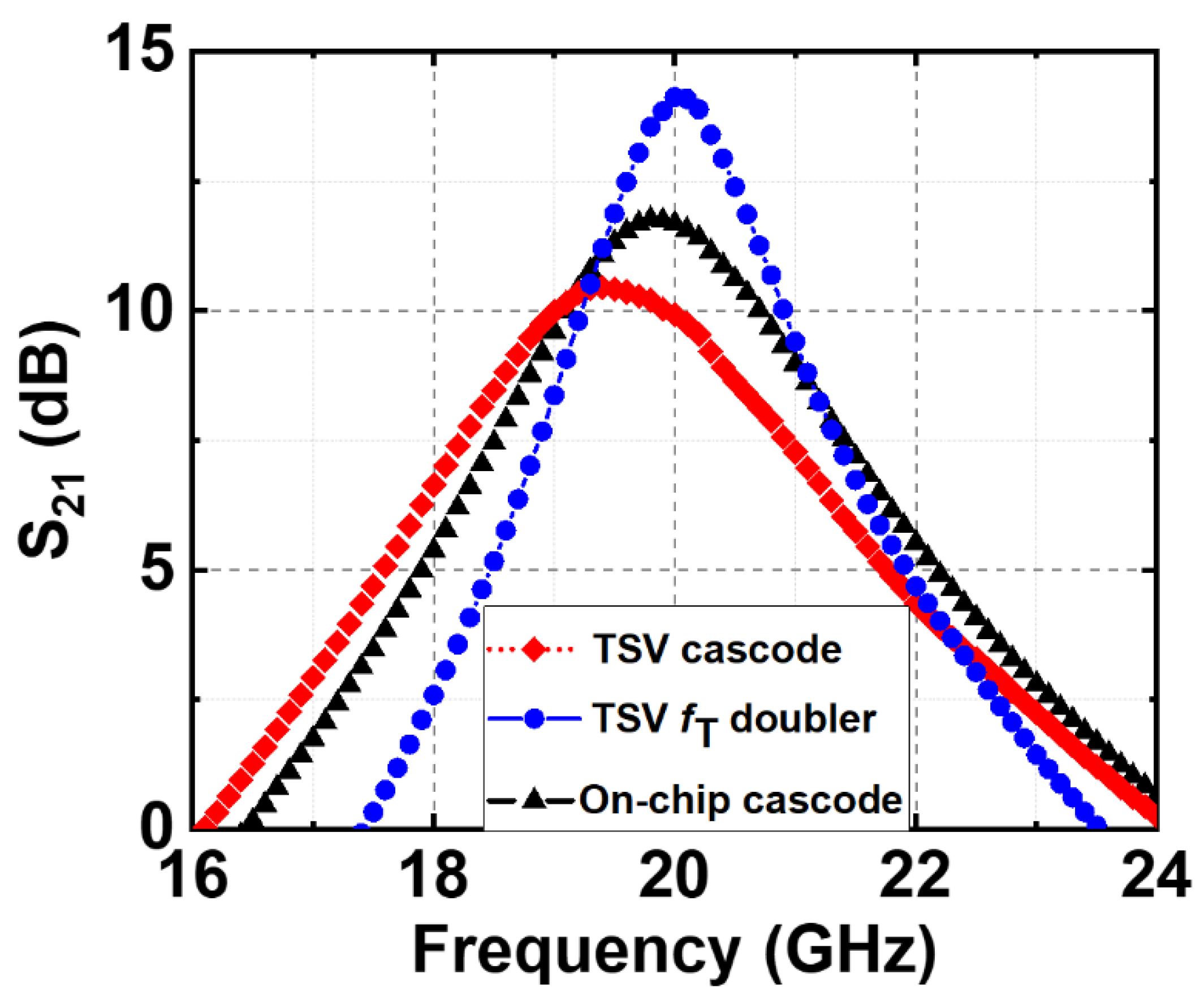


| RFA Type | fcenter (GHz) | Gain (dB) | NF (dB) | PDC (mW) |
|---|---|---|---|---|
| On-chip conventional cascode | 19.6 | 11.2 | 6.6 | 1.8 |
| TSV conventional cascode | 19.4 | 10.4 | 6.9 | 1.8 |
| Proposed TSV fT-doubler | 20.0 | 14.1 | 11.2 | 3.3 |
| RFA Type | Gain | NF | PDC |
|---|---|---|---|
| TSV cascode | −2.3 dB | +0.40 dB | <+2% |
| fT-doubler cascode | −2.9 dB | +0.43 dB | <+2% |
© 2020 by the authors. Licensee MDPI, Basel, Switzerland. This article is an open access article distributed under the terms and conditions of the Creative Commons Attribution (CC BY) license (http://creativecommons.org/licenses/by/4.0/).
Share and Cite
Sarker, M.A.R.; Song, I. Design and Analysis of fT-Doubler-Based RF Amplifiers in SiGe HBT Technology. Electronics 2020, 9, 772. https://doi.org/10.3390/electronics9050772
Sarker MAR, Song I. Design and Analysis of fT-Doubler-Based RF Amplifiers in SiGe HBT Technology. Electronics. 2020; 9(5):772. https://doi.org/10.3390/electronics9050772
Chicago/Turabian StyleSarker, Md Arifur R., and Ickhyun Song. 2020. "Design and Analysis of fT-Doubler-Based RF Amplifiers in SiGe HBT Technology" Electronics 9, no. 5: 772. https://doi.org/10.3390/electronics9050772
APA StyleSarker, M. A. R., & Song, I. (2020). Design and Analysis of fT-Doubler-Based RF Amplifiers in SiGe HBT Technology. Electronics, 9(5), 772. https://doi.org/10.3390/electronics9050772





